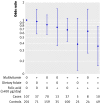Folic acid supplements and risk of facial clefts: national population based case-control study
- PMID: 17259187
- PMCID: PMC1808175
- DOI: 10.1136/bmj.39079.618287.0B
Folic acid supplements and risk of facial clefts: national population based case-control study
Abstract
Objective: To explore the role of folic acid supplements, dietary folates, and multivitamins in the prevention of facial clefts.
Design: National population based case-control study.
Setting: Infants born 1996-2001 in Norway.
Participants: 377 infants with cleft lip with or without cleft palate; 196 infants with cleft palate alone; 763 controls.
Main outcome measures: Association of facial clefts with maternal intake of folic acid supplements, multivitamins, and folates in diet.
Results: Folic acid supplementation during early pregnancy (> or =400 microg/day) was associated with a reduced risk of isolated cleft lip with or without cleft palate after adjustment for multivitamins, smoking, and other potential confounding factors (adjusted odds ratio 0.61, 95% confidence interval 0.39 to 0.96). Independent of supplements, diets rich in fruits, vegetables, and other high folate containing foods reduced the risk somewhat (adjusted odds ratio 0.75, 0.50 to 1.11). The lowest risk of cleft lip was among women with folate rich diets who also took folic acid supplements and multivitamins (0.36, 0.17 to 0.77). Folic acid provided no protection against cleft palate alone (1.07, 0.56 to 2.03).
Conclusions: Folic acid supplements during early pregnancy seem to reduce the risk of isolated cleft lip (with or without cleft palate) by about a third. Other vitamins and dietary factors may provide additional benefit.
Conflict of interest statement
Competing interests: None declared.
Figures

Comment in
-
Folic acid and birth malformations.BMJ. 2007 Mar 3;334(7591):433-4. doi: 10.1136/bmj.39133.386296.BE. BMJ. 2007. PMID: 17332537 Free PMC article.
-
Do folic acid supplements reduce facial clefts?Evid Based Dent. 2008;9(3):82-3. doi: 10.1038/sj.ebd.6400600. Evid Based Dent. 2008. PMID: 18927570
References
-
- Botto LD, Moore CA, Khoury MJ, Erickson JD. Medical progress: neural tube defects. N Engl J Med 1999;341:1509-19. - PubMed
-
- Munger RG. Maternal nutrition and oral clefts. In: Wyszynski DF, ed. Cleft lip and palate: from origin to treatment. Oxford: Oxford University Press, 2002:170-92.
-
- Shaw GM, Lammer EJ, Wasserman CR, O'Malley CD, Tolarova MM. Risks of orofacial clefts in children born to women using multivitamins containing folic acid periconceptionally. Lancet 1995;346:393-6. - PubMed
-
- Hayes C, Werler MM, Willett WC, Mitchell AA. Case-control study of periconceptional folic acid supplementation and oral clefts. Am J Epidemiol 1996;143:1229-34. - PubMed
-
- Werler MM, Hayes C, Louik C, Shapiro S, Mitchell AA. Multivitamin supplementation and risk of birth defects. Am J Epidemiol 1999;150:675-82. - PubMed
Publication types
MeSH terms
Substances
Grants and funding
LinkOut - more resources
Full Text Sources
Medical
